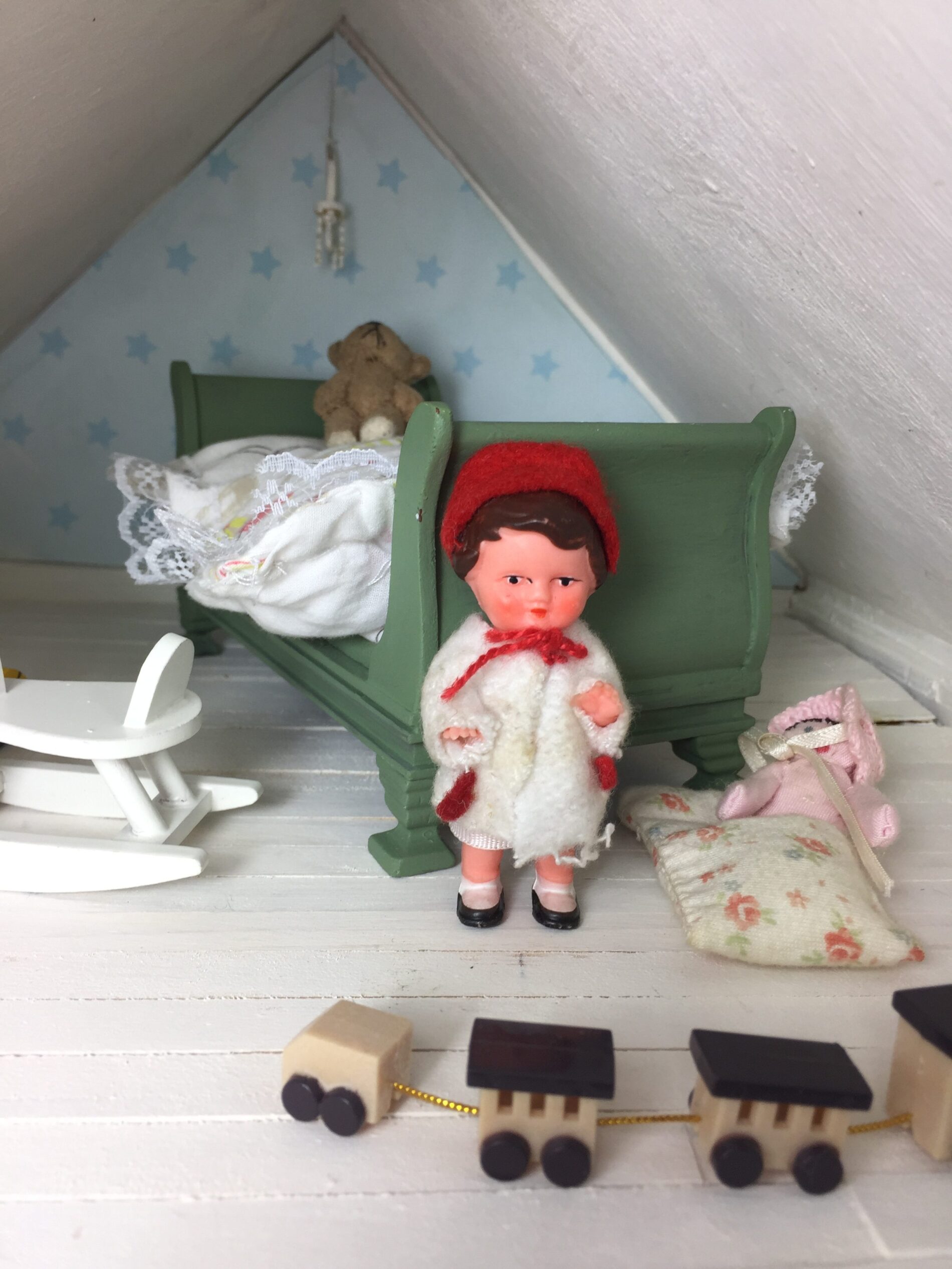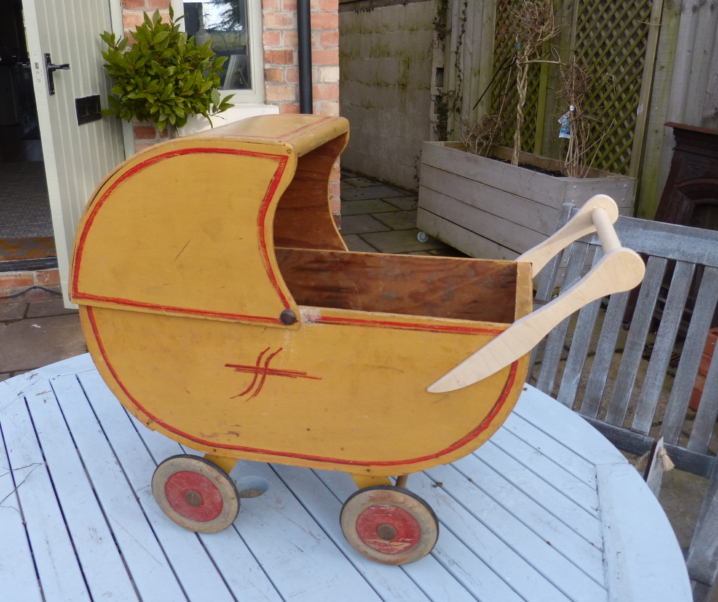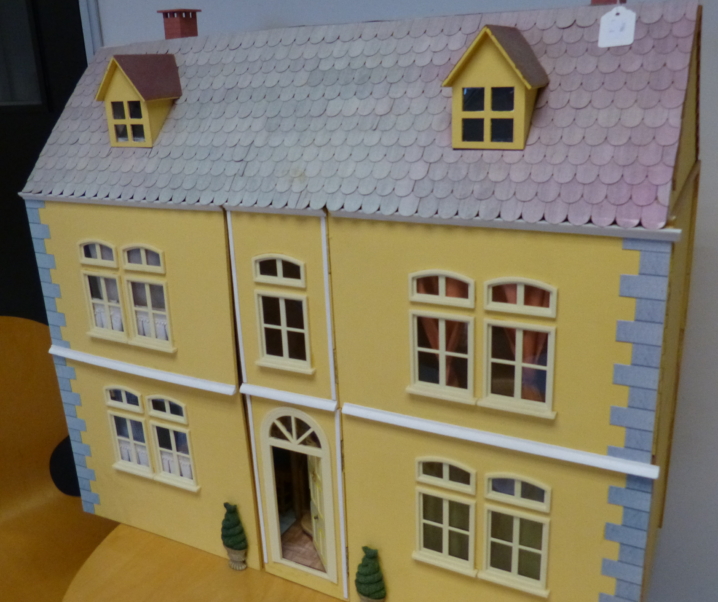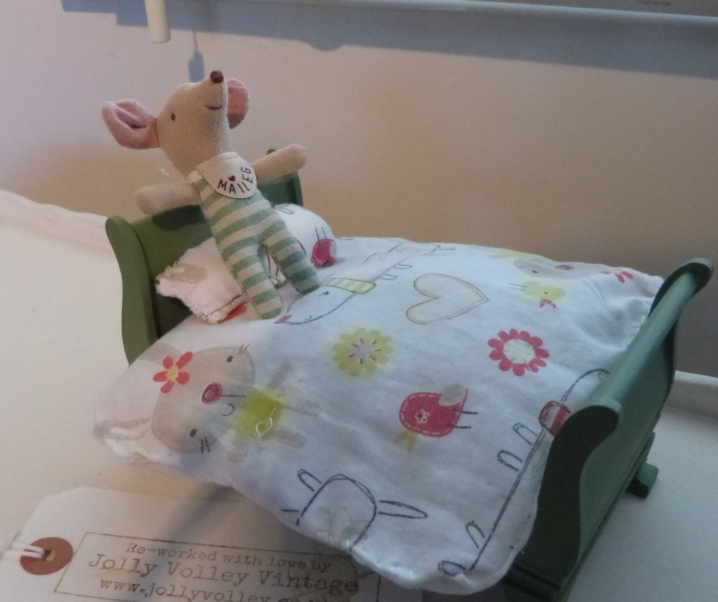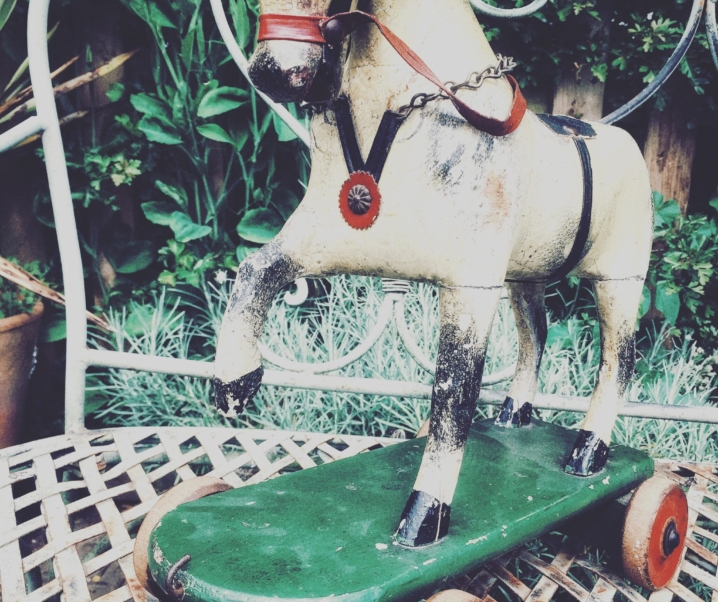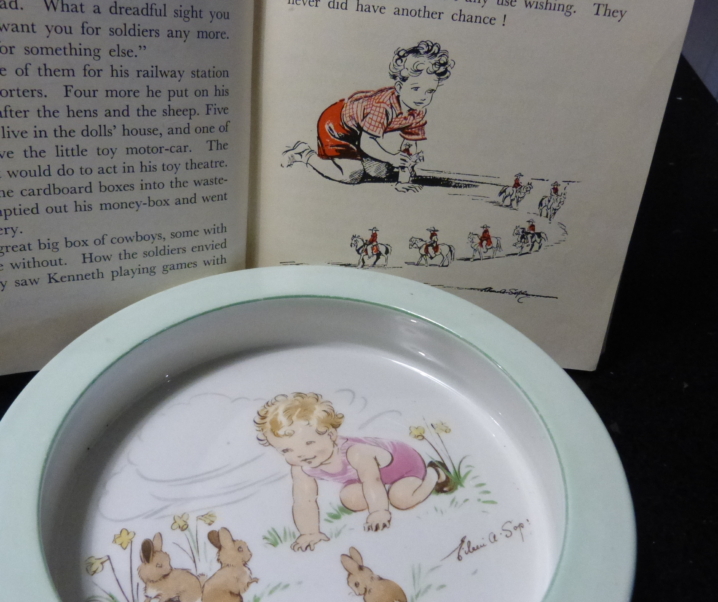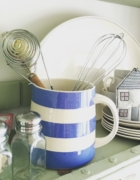Why do I love mini ARI German dolls? Let me count the ways. Could it be their chubby little faces? Or their tiny dimensions which means they have teeny tiny clothes; often knitted by Oma (the German equivalent of your nana).
Could it be that, in a world of scary looking dolls, these are really cute. Small wonder they are popular on Instagram.
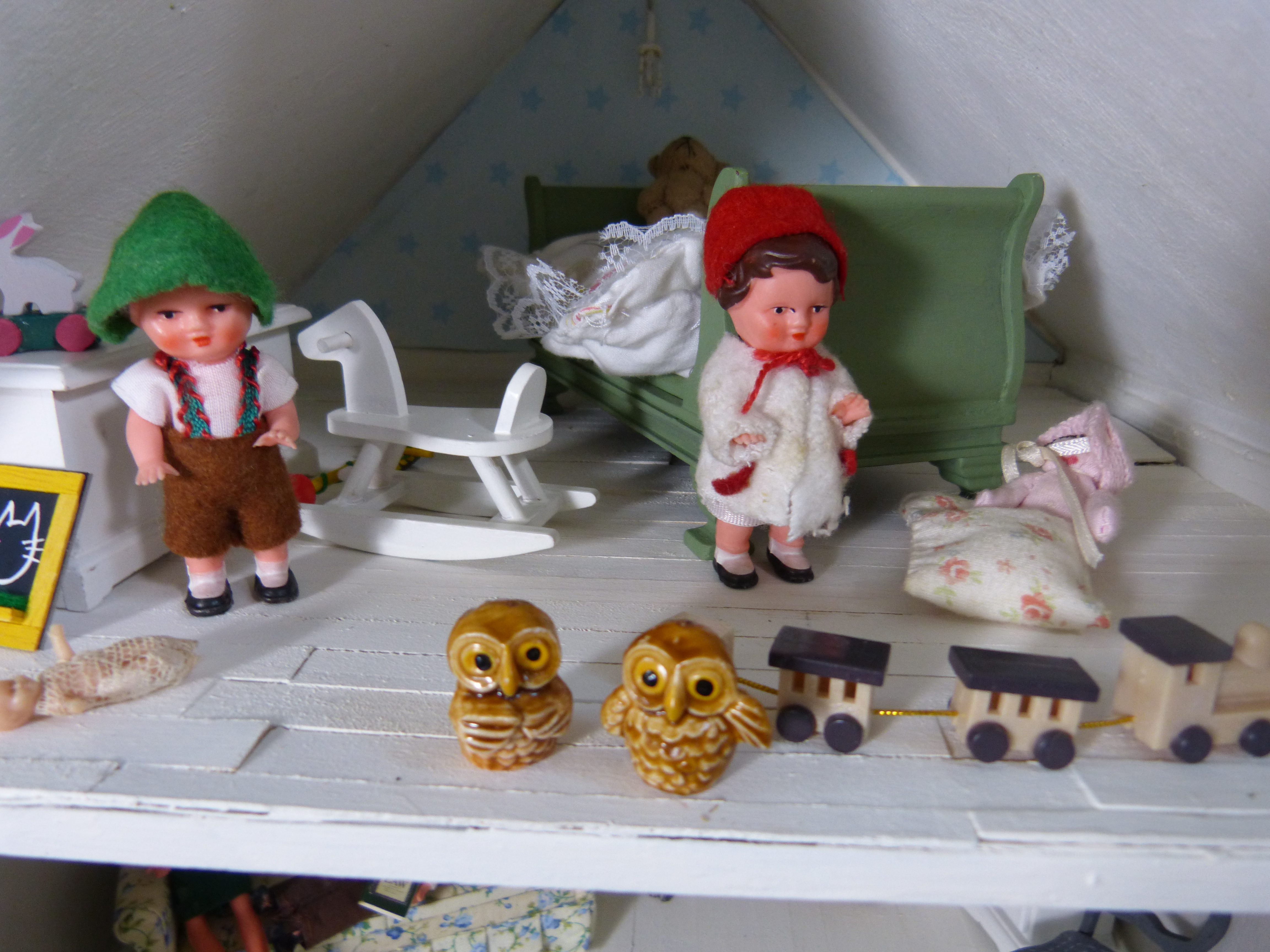
To be honest, I bought my Bavarian beauties (see above) because I was in love with the idea of making a wee profit on eBay.*
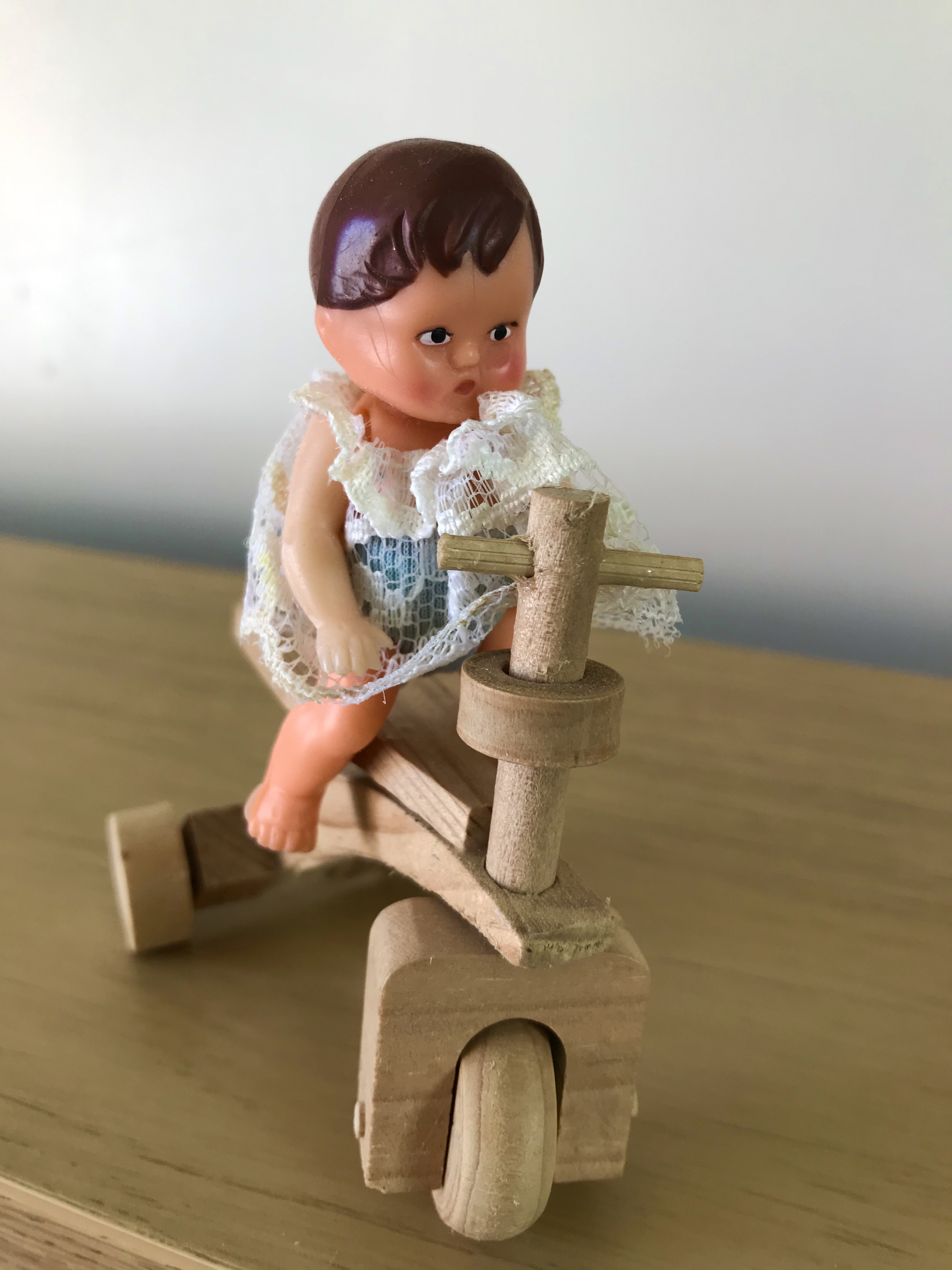
I spotted them in a miscellaneous box of vintage toys at a local auction house. A little research revealed the little girl doll alone could be worth £5-10. Throw the boy on top – oh er missus – then the combined sale would pay for the rest of the toys including the owls (see above) in style ‘too-witch’ they’ve become accustomed.
The problem was – they had no marking. ARI dolls are often identifiable by a triangular shaped marks on their backs, just below the neck (see below). The mark ARI (stands for August Riedler founder of the doll-making company) is usually in the triangle, with Germany and the ID number of the doll below.
Without this mark, were my Alpine-inspired duo genuine ARI? There was certainly nothing on their backs other than a bit of grime. They also had black shoes rather than the more traditional red.
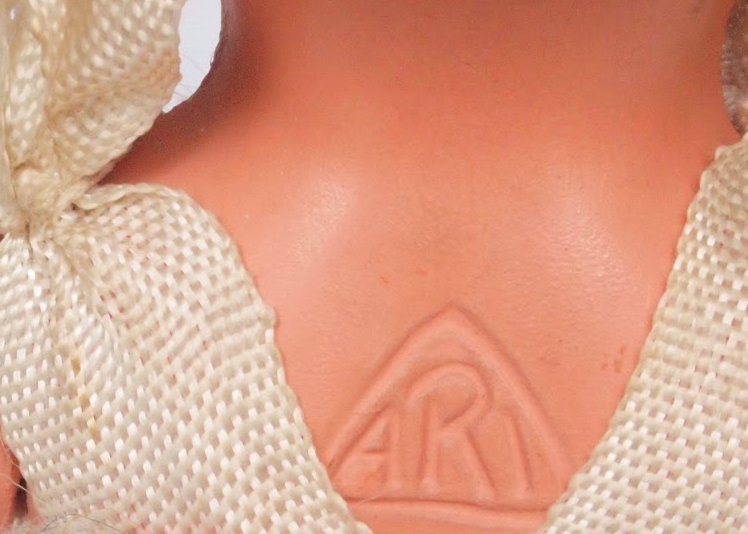
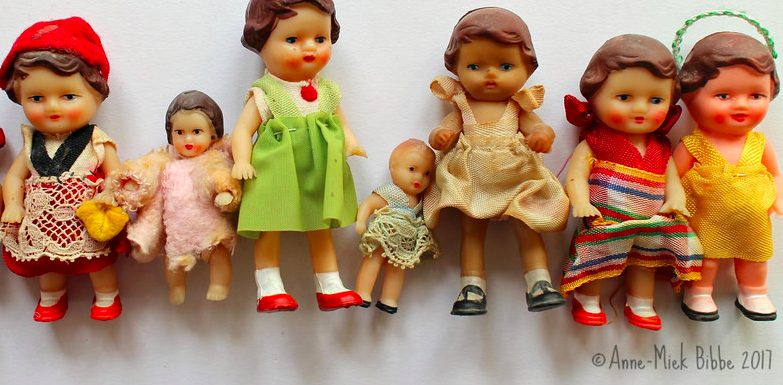

With no marking or provenance, I could almost hear Philip Mould on BBC’s Fake or Fortune making this damning conclusion. “Your dolls are in the style of ARI and they were probably made by ARI – but without the mark, red shoes and 106 signed documents from August Riedler himself, your dolls are worth diddly squat.”
I didn’t lose heart as it seemed unlikely that a counterfeiter could be bothered to copy a doll which, even at its height, could be bought for a few pfennings. You can understand people imitating Rembrandt but an ARI doll? They were, and still are, pocket-money toys.
Then I saw it. Scrolling down the brilliant The Doll’s House Collector blog and examining all the ARI doll pictures a bit more carefully – my exact doll described as a Red Riding Hood Figure. This little doll was the exact copy of mine from her red hat down to her black shoes. It wouldn’t convince Philip Mould – or even that nice co-presenter Fiona Bruce – but it’s enough for me…
- I did sell the dolls but – as I didn’t dare say they were genuine ARI – I got a paltry £8 for the pair.
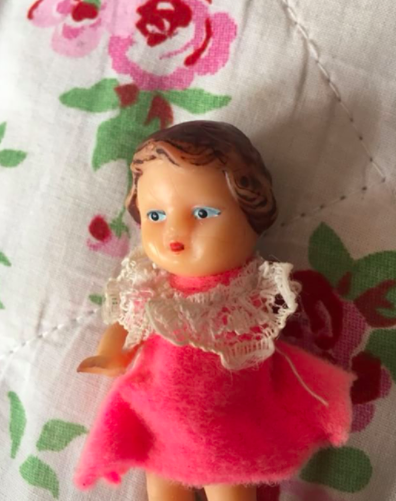
- Why we are wild about ARI – collector Helen O’Brien, who shares lots of dolly pictures on her Instagram account @poorlittlenell
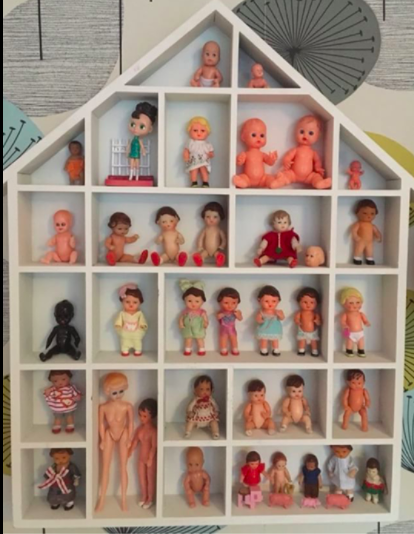
- “From the age of one until five, I lived in Africa and Bahrain. My gran, Jean O’Brien, lived in England and would send me 70s style Ari dolls. I loved these dolls so much and I called them Jason – after the boy who lived next-door to gran. When we came back to England, I remember her taking me into a newsagent in Yarm, near Stockton-on-Tees, and buying me a ‘Jason’ from cards of ARI dolls which hung near the counter.
-
- “I have three ‘Jasons’ who travel around the world with me. Including ‘One Arm’ (pictured above). I moved back to the UK in 2009 and I have really started to collect dolls including ARI – especially from the 1970s, the style my gran gave me. It’s a nostalgia thing – and better for me than hitting the bottle!”


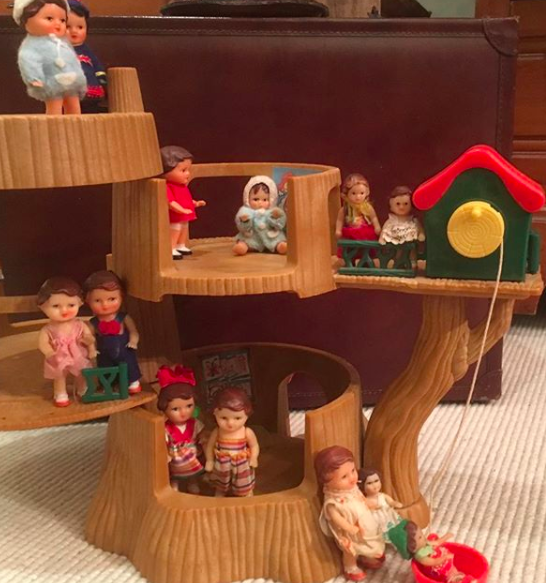
Why we are wild about ARI – collector Jane Chapman, of Bath, is fascinated by all thing miniature and creates magical Fairy Furniture.
“I love the character each one seems to have,” says Jane.
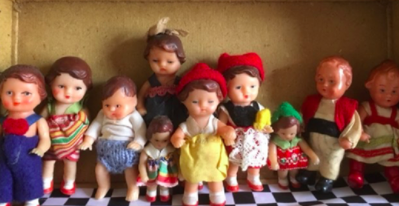
“Even though they all seem to be made the same way, on closer inspection, some of them look gentle, cross or sad and just lend themselves to story-telling.”
For more miniature loveliness; see Jane’s Instagram feed; awaywiththefairies277
Ten little facts about miniature ARI doll
They were inexpensive little dolls with a lot of charm. The features, like lips and shoes, were often hand-painted and the limbs were articulated (moveable). The outfits were naive (often poorly made) and popular figures included Bavarian costumed ARI , Red Riding Hood figures and school teachers. They also had accessories like furniture, toys (made for tiny ARI babies) and tea services.
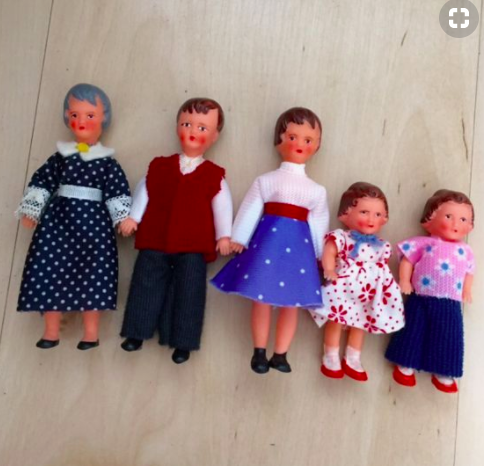
 They could also be bought in family groups. A 1950s advert for an ARI dolls (above) shows a whole ARI family. Parents, two children family, the nanny and a maid? The addition of a house-maid is surprising seeing as these were sold in Socialist East Germany.
They could also be bought in family groups. A 1950s advert for an ARI dolls (above) shows a whole ARI family. Parents, two children family, the nanny and a maid? The addition of a house-maid is surprising seeing as these were sold in Socialist East Germany.

The production was a family affair. The company grew from a cottage industry started by August’s Riedeler’s wife Johanna; in those early years all the dolls were made from porcelain (see left). After the war August’s granddaughter Leonore – together with her husband Horst Steinmann – started to make synthetic dolls from moulds. Soon, they were capable of churning out four thousand dolls every day.
They were sold all over the world. By 1964, the company was producing 30/40 thousand dolls a day; exporting 90 per cent to counties including the US, Canada, South America, Australia, South Africa, Iraq and the United Arab Republic (modern names). ARI was one of the ten largest companies in East Germany.
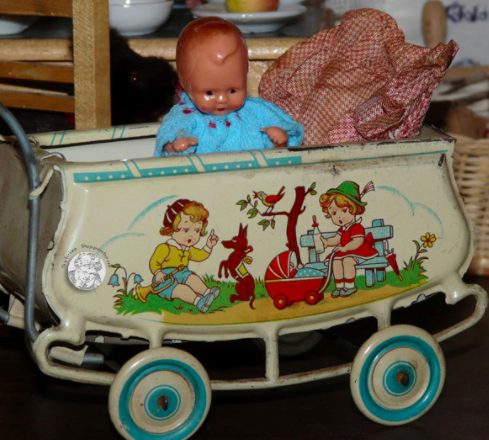
They were nationalised by the socialist GDR state. Business continued as normal. Horst Steinmann was retained as director and factory had just two state-appointed employees amongst the 1200-strong workforce. The change in ownership didn’t dent production at all; during the 50s the factory was churning out 50,000 dolls a day.
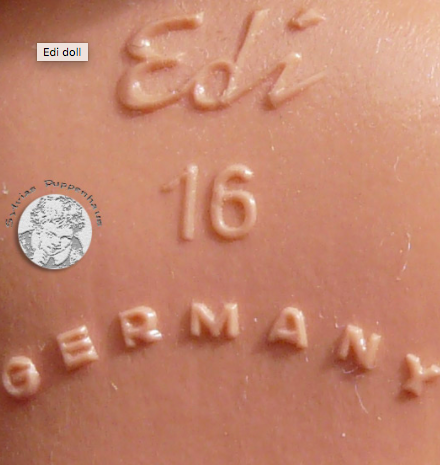
They set up a break-away factory in West Germany. In 1946, ARI’s creative director – Oskar Oelzner – opened a factory in West Germany. The new factory had a West German ‘front man’ called Erich Dittmann (a merchant who had been making toys but not dolls). With machinery financed by ARI, Dittmann began the manufacturer of ‘Edi’ dolls at the grand Villa Genienau in Mehlem (Bonn).

 The little dolls made their new makers a fortune. Oskar Oelzner’s daughter recalled the luxury of growing up at the mansion – the cheap little dolls were, she recalls, ‘a gold mine’.
The little dolls made their new makers a fortune. Oskar Oelzner’s daughter recalled the luxury of growing up at the mansion – the cheap little dolls were, she recalls, ‘a gold mine’.
They landed with a bump. Dittmann treacherously grabbed ownership of the entire factory from his East German counterparts when the Iron Curtain fell but – when his other business ventures failed – he was forced to close the villa-based factory in 1960.
The company fortunes toppled after re-unification. After the fall of the Berlin Wall in 1989, the Steinmann family regained control of their company from the state. Unfortunately, the firm was locked into buying expensive supplies from German producers and could not compete with cheaper imports from China. The company tried to revive fortunes by raiding their back catalogues and making ‘reproduction’ porcelain dolls (see below) with half of their stock made under licence in the Far East. In 1994, sales topped eight million DM – buoyed by the sale of plastic gnomes – but it was a case of too little, too late…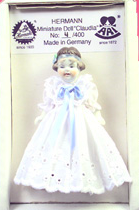
Two years later, ever tumbling sales caused the company to file for bankruptcy. In May 1999, the equivalent of a ‘whole street’ was knocked-down in Konigsee when the factory was demolished, including an oven filled with bespoke plaster moulds.
They had one last outing. The last porcelain ARI dolls ever made – by Horst’s son Uwe under the name ARI-Dolls-Uwe Steinmann – can still be viewed on a defunct trade website. The website features ten dolls – one of being the ‘Claudia” doll (right) – being distributed in America in 1998. Only 400 were made of each doll and they stood at just 3.5 inches tall .
Sadly, this inactive website is all that remains of the last ARI dolls….
Sources: On the trail of Edi Dolls – General-Anzeiger
The Dollhouse collector blog contains a definitive Ari and Edi history plus lots of photographs.
For fabulous pictures of Edi dolls; Sylvia’s Dollhouse blog.
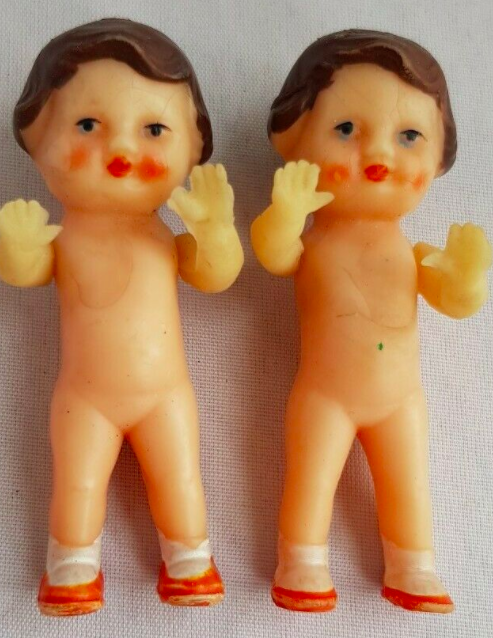
Starting a collection? ARI dolls were made in hundreds of thousands, which means there are plenty around in auctions, markets and on eBay/Etsy. There are no records of when the dolls were made, so dating them is difficult. The dolls were made from moulds so they hardly change in appearance over the years.
The popularity of collecting ARI – for doll’s houses and for photographing on Instagram – has sent their prices soaring (the naked ARI at the top sold for £15). In May 2020, two little ARIs in poor condition sold for £10, a naked doll and one in a spotty dress in good condition for £9.99 and an ARI with a pram £15. Over on Etsy, I have seen one doll (perfect costume) marketed for just a little shy of £45.
Clearly, the popularity of ARI has affected price. It’s down to personal choice but the most I’d pay for a clothed doll would be £8-10.
Scout through ‘job-lots’ of doll’s house figures, miniature dolls and dolls house items. Sometimes it’s possible to spot an ARI nestling within a pile of otherwise unidentified vintage dolls or dolls house bundles.


